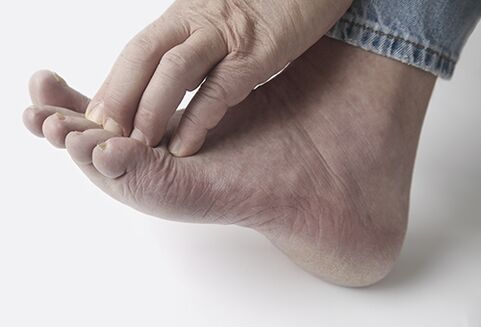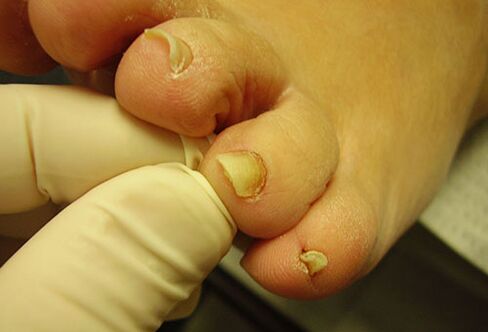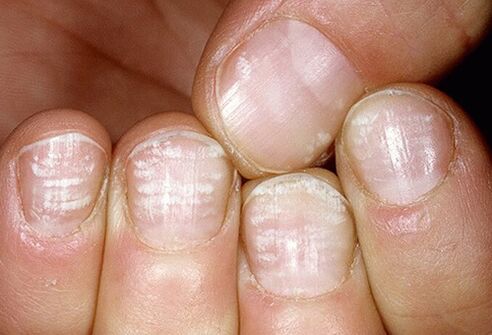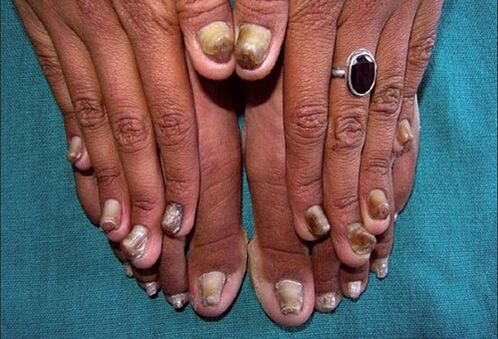Nail fungus cannot be confused with anything at an advanced stage, when it is almost impossible to cure them. But if you know the earlier symptoms of nail fungus, then it will not be too late to start fighting the infection, and nail loss can be avoided. But in different cases, the fungus looks different, so first you need to understand a little about the nature and course of the disease.

General signs of disease
Regardless of the type of fungus, variety, course of the disease, and even the stage, these symptoms will remain unchanged and will definitely indicate onychomycosis in development or already in progress.
- A change in the color of the nail plate is a key sign from which the disease begins to develop. Shades can vary from whitish to black, but the most common color of fungal nail is brownish yellow.
- An unpleasant odor always accompanies onychomycosis, although it may not be very noticeable in the initial stages. True, you will find it difficult to sniff under your feet, and the specific smell will become noticeable already in the stage of disease development.
- Stratification, crumbling and peeling of the nail plate does not start immediately, but it is these signs of nail fungus that make most people sound the alarm. If these symptoms are moderate and appear locally, there is still a chance that the nail will return to a healthy appearance.
- Painful sensations rarely appear in the initial and developmental stages, but as the disease progresses, discomfort and pain cannot be avoided: in any case, they will appear either due to deformation, or due to destroyed nail plate, or due to the beginning of inflammation with pus.
- Burning and itching of the skin should also not be neglected. Moreover, in the initial stage, it is these symptoms that can help to recognize the disease, because in some cases it spreads to the nail plate from the skin on the side or back ridges or cuticles.
Among other things
Onychomycosis is much more common on toenails, while fungus on the hands comes much less often, most often after contact with the affected toenails.

Symptoms of foot fungus
It seems that you already know how to recognize nail fungus, but this information is quite general, although it will help you in the accurate diagnosis of onychomycosis. The fact is that there are more than 50 types of fungi that can cause it, and the course of the disease is about 10. It is better to know in advance what awaits you in each of the possible scenarios.
More than 90% of all cases of onychomycosis on the feet are caused by dermatomycetes, slightly less than 10% - yeast-like fungi, and only a small part - mold.
Different types of nail fungus give different symptoms.
- In normotrophic fungus, the nail plate itself is not deformed, and the most noticeable manifestation of the disease is a change in the color of the plate on the side to yellowish-brown. At the same time, its thickness does not change, it does not crumble, and the natural shine does not disappear. If you do not deal with the treatment of normotrophic fungus, it will affect an increasing area, the plate will begin to peel and can be completely detached.
- Hypertrophic fungi cause the nail plate to thicken, which leads to the formation of claw-like growths. In the advanced stage, such a fungus causes discomfort and often pain when walking, and, of course, nail damage is accompanied by a change in color to grayish or yellow. Such nails lose their natural shine and begin to crumble and peel.
- If you are faced with atrophic fungus, then the risk of losing the plate without proper treatment is extremely high. Such a fungus gradually destroys the nail plate, making it loose and peeling, which leads to its atrophy. In the initial stages, it is difficult to distinguish atrophic flow, because it is accompanied only by loss of gloss and change in the color of the plate to yellow, brown or gray.
Less typical are lateral-distal mold with nail plate blackness, pain, suppuration, and nail plate atrophy at an advanced stage; proximal fungus with white spots in the growth zone and damage to the nail plate on the side of the cuticle, as well as white surface fungus that manifests itself in the form of small white spots on the nail, which gradually grows and occupies an increasing area.
Among other things
The older a person is, the more susceptible they are to fungal nail diseases. Also, the appearance of fungi can be influenced by climate, hygiene and sex.

Symptoms of fungus on the hands
On the hands, the main 3 variants of the course of the disease do not differ from those found on the feet, only the distribution of the causes is somewhat different: approximately 30% and 45% are caused by dermatomycetes and yeasts. fungi, or slightly less than 15% are molds, and a smaller number of infections are caused by other fungal organisms.
The main symptoms are also the same for the plates on the arms and legs, and the affected areas look similar. The only difficult thing may be the question of how to recognize the fungus on the nails in rare cases, such as infection with rubromycosis or trichophyton, but it is more of a task for qualified doctors.

Fungal progression
If in the initial phase the disease does not look scary and thoughts of serious treatment are rarely visited, they are increasingly being replaced by folk methods, then in the advanced stage it will not be possible without long-term treatment. And even that won’t be able to guarantee that the nail will stay with you.
- It would be ideal to start the disease at an early stage, but it is almost impossible to determine outside the laboratory: all symptoms have a barely noticeable manifestation. Although a few signs can still be seen. If you notice that something is wrong with the skin, for example, cracks, blisters or stinging may appear, it is a clear sign of onychomycosis on the nails. If you see that the color of the nail plate has started to change along the edges or from one edge, this is also a cause for concern.
- Usually, the fungus becomes noticeable in the development phase, and in order to notice it as early as possible, you must regularly do at least a simple pedicure and monitor the condition of the nails and skin of the feet. During this period, the nail plate looks unhealthy, loses its shine, a significant change in color begins, and closer to the beginning of the advanced phase, the nail begins to deform, peel and crumble.
- In the advanced phase, the nail will definitely actively collapse: stratify, break, loosen until the complete destruction of the nail plate, and even damage to the nail. In order for the disease to reach an advanced form, it must be ignored for a long time, suffering from itching, discomfort, disgusting appearance and unpleasant smell, which people still do not do often. Therefore, this phase is typical for the rapid development of fungi in old age or in the presence of certain diseases.
It is important to remember that untreated nail fungus can turn into foot fungus, and this disease is even more unpleasant and more difficult to treat.
It is not so difficult to determine the presence of nail fungus at least in the developmental stage, but it is better to entrust qualified experts to determine the cause and type of flow. Do not neglect the help of a doctor and contact them at the first suspicion of the disease.
























